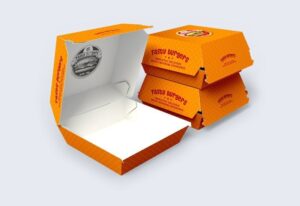Selecting the right materials for burger boxes is crucial for maintaining food quality, enhancing presentation, and ensuring functionality. This guide will explore the various materials available for burger boxes, their advantages, and considerations to keep in mind. By understanding the different options, you can make informed decisions that best suit your needs and brand requirements.
Understanding the Importance of Material Selection

Choosing the appropriate material for burger boxes impacts several aspects of your product, from food safety to branding. The right material ensures that your burgers remain fresh, secure, and visually appealing. It also plays a role in the environmental footprint of your packaging.
Key Considerations for Material Selection
1. Food Safety
Food safety is a primary concern when selecting materials for The Burger boxes. The material should be able to handle the heat and moisture from burgers without compromising food safety. Materials that offer moisture resistance and are free from harmful chemicals are ideal.
2. Durability
The durability of the material affects how well the burger box can withstand handling and transportation. A durable material helps prevent leaks and maintains the box’s integrity during delivery.
3. Environmental Impact
Sustainability is becoming increasingly important. Opting for eco-friendly materials can reduce your environmental footprint and appeal to environmentally-conscious consumers.
Types of Materials for Burger Boxes
Different materials offer various benefits for burger boxes. Here’s a breakdown of the most commonly used materials:
1. Paperboard
Paperboard is a popular choice for burger boxes due to its lightweight and versatile nature. It is made from layers of paper pulp, making it both strong and flexible.
Advantages of Paperboard
- Cost-Effective: Paperboard is generally more affordable than other materials.
- Customizable: It can be easily printed on, allowing for vibrant branding.
- Recyclable: Many types of paperboard are recyclable, making it a more sustainable option.
Considerations
- Moisture Resistance: Paperboard may require a coating to resist moisture from the burger.
- Strength: While strong, it might not be as durable as some other materials.
2. Kraft Paper
Kraft paper is known for its natural brown color and durability. It is produced from wood pulp through a process that retains much of the paper’s strength.
Advantages of Kraft Paper
- Durability: Kraft paper is strong and can handle heavier loads.
- Eco-Friendly: It is often biodegradable and recyclable.
- Natural Look: Provides a rustic, natural appearance that can be appealing.
Considerations
- Printing Limitations: The natural color may limit printing options for vibrant designs.
- Moisture Protection: Like paperboard, Kraft paper may need additional coating for moisture resistance.
3. Plastic
Plastic burger boxes are durable and can offer a high level of protection. They are often used for their ability to keep food fresh and secure.
Advantages of Plastic
- Durability: Plastic is very strong and resistant to moisture.
- Clear Options: Transparent plastics allow customers to view the contents.
- Leak-Proof: Many plastic options are designed to prevent leaks.
Considerations
- Environmental Impact: Plastic is not as eco-friendly as other materials and can be less sustainable.
- Cost: Generally more expensive than paper-based options.
4. Biodegradable Materials
Biodegradable materials are becoming more popular as environmental awareness grows. These materials break down naturally, reducing their impact on landfills.
Advantages of Biodegradable Materials
- Eco-Friendly: Reduces the environmental footprint and is a sustainable choice.
- Versatility: Available in various forms, such as biodegradable plastics and paper.
Considerations
- Cost: Often more expensive than traditional materials.
- Availability: May not be as widely available as other materials.
Final Words
Selecting the right materials for burger boxes involves balancing factors such as food safety, durability, environmental impact, and cost. Each material has its own set of advantages and considerations. By evaluating these factors and choosing materials that align with your brand values and operational needs, you can enhance the overall quality and sustainability of your burger packaging.

